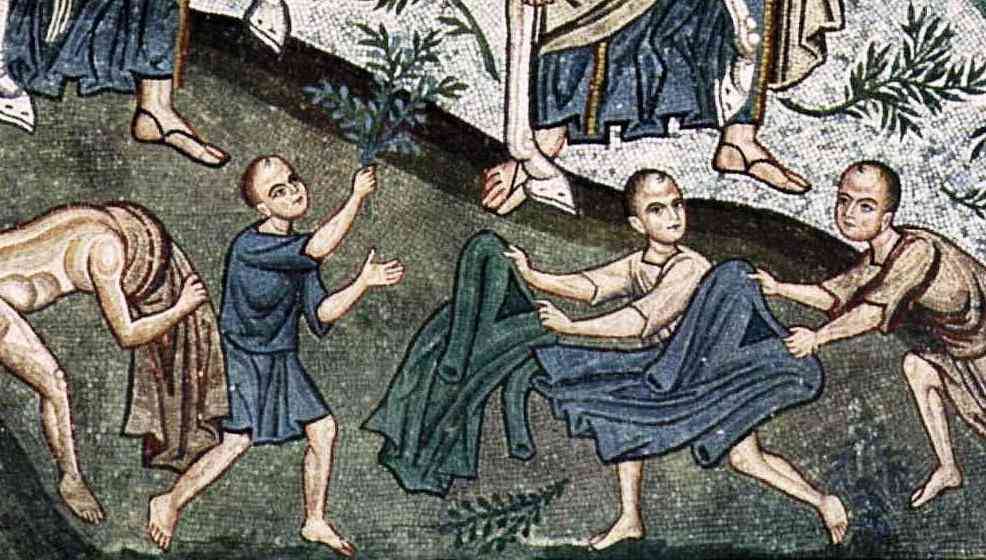
Palermo Mosaic: Children in Biblical Scene

Figure 1.--Here we have a mosaic of the Chapel of Royal Palace of Palermo (Sicily), that dates to the mid-12th century. The mosaic is an illustration of the Gospel of Matthew (21:8) "A very great multitude spread their clothes". The mosaic provides some useful information about comtemporary clohing. People wore long robes. Children alsdo wore these robes. This detail from the mosaic provides valuable details about children's clothing. The mosaic suggests the robes worn by children could be cut shorter. The mosaic also suggests that some people wore a short-sleeved tunic under their robe and other prople wore mnothing under it. Children were also more likely to be barefoot. We are not sure why the boys have such short hair. .
|
|
Here we have a mosaic of the Chapel of Royal Palace of Palermo (Sicily), that dates to the mid-12th century. The mosaic is an illustration of the Gospel of Matthew (21:8) "A very great multitude spread their clothes". The mosaic provides some useful information about comtemporary clohing. People wore long robes. Children alsdo wore these robes. This detail from the mosaic provides valuable details about children's clothing. The mosaic suggests the robes worn by children could be cut shorter. The mosaic also suggests that some people wore a short-sleeved tunic under their robe and other prople wore nothing under it. Children were also more likely to be barefoot. We are not sure why the boys have such short hair.
Mosaic
Here we have a beautifully done medieval mosaic. Many magnificent mosaics were done in churches throughout Italy. This one is located in the Chapel of Royal Palace in Palermo, Sicily.
Chronology
The mosaic dates to the mid-12th century. This would be just before the Renaissance began to transdform Italian art.
Biblical Scene
The mosaic is an illustration of a scene from the Gospel of Matthew (21:8). Jesus is nearing Jerusalem. Depicted is a scene outside of Bethphage near the Mount of Olives. The passage read, "And very great multitude spread their garments in the way; others cut down branches from the trees and strawed them in the way." The idea was apparently to cover the bare road as a way of honoring Jesus. And this is what we see here.
Children
The mosaic is a little different than what is described in Matthew. St. Matthew tells us that the multitude "spread their garments". But the idea of a multitude of people taking off their clothes seems to have bothered the Church fathers as aittle unseemly. So only the children are depicted here. We know the four figures at the bottom are children because they are depicted as much smaller thabn the adults. This was the convention in pre-Renaissance art.
Hats
One interesting aspect of the mosaic is that no one is wearing hats. It maywell be that the artists worlkking on the mosaic did not want the complication of headwear. But we are left wondering what hats were worn at the time.
Hair
The four children in sharp contrast to the adults are shown with short hair. Perhaps they were shaved, but I don't know the cause. This is not something I have noted in other medieval images.
Robes and Tunics
The standard item of dress in medieval Europe was a long robe. These robes and the dresses worn by women were in many ways similar. Children wore the same robes, often cut somewhat shorter than the robes adults wore. Colors were plain. In art work we at first see shades of gray, brown, green, dark blue, and dull reds. The mosaic provides some useful information about comtemporary clohing. People wore long robes. Children alsdo wore these robes. This detail from the mosaic provides valuable details about children's clothing. The mosaic suggests the robes worn by children could be cut shorter. The mosaic also suggests that some people wore a short-sleeved tunic under their robe and other prople wore nothing under it. We are some what unsure how to interpret the clothes the four children are wearing.
Boy 1
The first boy is taking his robe off. Apparently he was not wearing anything underneath.
Boy 2
The second boy is wearing a robe, but cut much shorter than those worn by the adults. It is not shown if he is wearing anything under his robe. He is laying branches on the road as described as St. Matthew.
Boy 3
I think the third boy has taken off his robe and is weating la white/tan tunic or mantel. One indication that the tunic he is wearing is an undergarment is that all of the adult figures above are wearing sdark colored robes. Non one wears a light colored garment like the tunic the boy here is wearing. The lengh of boy's tunic is not shown. A reader has aent take on the boys' clothing. "Perhaps the adults wore something more than the robe and the mantel, but the children seem wearing the short robe as the only garment." This would mean that the robes they are laying on the road were not the garments they were wearing.
Boy 4
We think that the fourth boy is essentially a repeat of the fourth boy. Only here the length of the tunic is shown. It is depicted as about the same length as the darker colored robes that the boys are wearing and the boy here has taken off.
Footwear
Children were also more likely to be barefoot. The footwear worn by Jesus and Apostles could be inspired by the New Testament that always mentions "sandals". So it may not reflect contemporary footwear.
HBC

Navigate the Historic Boys' Clothing Web Site:
[Return to the Main medieval garment page]
[Return to the Main medieval clothing page]
[Return to the Main medieval page]
[Introduction]
[Activities]
[Art chronologies]
[Biographies]
[Chronologye]
[Countries]
[Style Index]
[Bibliographies]
[Contributions]
[FAQs]
[Glossaries]
[Images]
[Links]
[Registration]
[Tools]
[Boys' Clothing Home]
Created: 9:17 PM 6/28/2009
Last updated: 9:18 PM 6/28/2009



